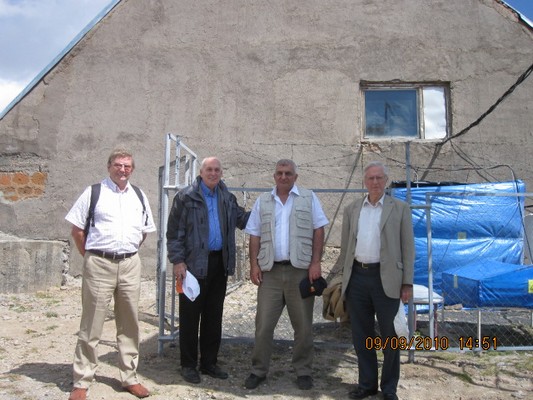International Conference on Cosmic Radiation and Thunderstorms at Armenia's Cosmic Ray Division
By Joseph Dagdigian
October 15, 2010

From left to right: Prof. Michail Panasuk, director of the Skobeltsyn Institute of Nuclear physics, Moscow State Univ., Russia; Prof. Gerald Fishman, NASA-Marshall Space Flight Center, USA; Prof. Ashot Chilingarian, director of Artem Alikhanyan National Laboratory and head of the CRD, Armenia; Sir Arnold Wolfendale, Royal Astronomer, Great Britain. Taken at the Aragats cosmic ray research station on Mt. Aragats near the new facilities for detection of the elementary particles from the thunderstorm clouds.
The international Thunderstorms and Elementary Particle Acceleration (TEPA-2010) conference was held from September 6 through 11, 2010 at the Cosmic Ray Division (CRD) Nor Amberd international conference center on Armenia.s Mt. Aragats. The conference focused on the interaction between cosmic radiation and thunderstorms.
This was the first time such interactions were considered in all their aspects by some of the world.s major research institutions. Researchers have discovered complex and unexpected interactions between high energy cosmic ray particles and thunderstorms forming in the earth.s atmosphere. Energetic cosmic ray particles can strip electrons away from atoms in the atmosphere, thus causing electrical conduction paths which can trigger lightening strikes. These avalanches of very fast moving electrons travel with velocities approaching the speed of light. For such electrons Einstein.s Theory of Relativity must be applied to accurately describe their properties. This phenomena is called .Relativistic Runaway Electron Avalanche. (RREA). Electric fields within thunder clouds can, in turn, accelerate electrons upward where they ultimately are captured in radiation belts surrounding the earth where they can damage earth-orbiting satellites and cause high levels of radiation at altitudes used by commercial and military aircraft. Generation of intense electro-magnetic fields can disrupt sensitive electronic devices such as pacemakers used by passengers in commercial aircraft. Another key aspect of this research includes effects on space weather; the near earth electrical and magnetic environment which can adversely affect radio communications, produce radiation storms, and endanger satellites and astronauts in orbit. The CRD is a leader both in ground based space weather research and on the interaction of cosmic radiation and thunderstorms.
Forty scientists and students from U.S.A., U.K., Germany, Mexico, Russia, and Armenia attended the conference at which 37 original state of the art research papers were presented. The lectures included those of Sir Arnold Wolfendale, Durham, U.K. on climate change and possible influence of cosmic rays on the origin of life; Prof. Anatoly Petrukhin, Russian Nuclear Research University, on a new explanation of high-energy cosmic ray energy spectra; and Prof. Razmik Mirzoyan of Max Plank Institute in Munich discussing the history and future of Cherenkov gamma ray astronomy. From the United States Dr. Gerald Fishman from the U.S. space agency, N.A.S.A., presented a paper entitled .Terrestrial Gama-Ray Flashes. on behalf of Dr. Michael S. Briggs from the University of Alabama in which he described the production of intense flashes of electromagnetic radiation in the atmosphere.
The participation of 10 young CRD students in the discussions amplified their determination to pursue advanced studies and to participate in Armenia.s scientific advancement. Presenters from the Cosmic Ray Division, in addition to CRD.s head Prof. Ashot Chilingarian, included both experienced and young scientists and engineers: B. Mailyan, A. Hovhannisyan, A. Bostanjyan, A. Daryan, G. Hovsepyan, L. Vanyan, A. Reymers, and D. Pokhsraryan. The CRD presentations focused on the various aspects of the first ever measurement of the energy distribution of the Relativistic Runaway Electron Avalanches and Gamma radiation observed and captured at CRD.s detectors on Mt. Aragats
The CRD is
part of Armenia.s Artem Alikhanyan National Laboratory (AANL), formerly
known as the Yerevan Physics Institute, named after Artem Alikhanyan,
the founder of the CRD and the AANL who was one of the world.s leading
physicists. The CRD and the AANL are headed by Prof. Ashot Chilingarian.
Prof. Chilingarian considers it essential for the future of Armenian
science that talented young Armenian scientists and engineers participate
in international conferences and be introduced to the international
scientific community. Conference presentations are currently available
on-line at the CRD web site at:
http://crd.yerphi.am/
Conference sponsors were Armenia.s Artem Alikhanyan National Laboratory, the international Committee on Space Research (COSPAR), and the Armenian State Science Committee.
More information about the CRD is available at the Support Committee for Armenia's Cosmic Ray Division web site at http://www.crdfriends.org .